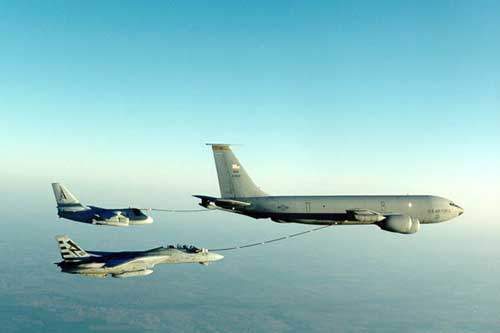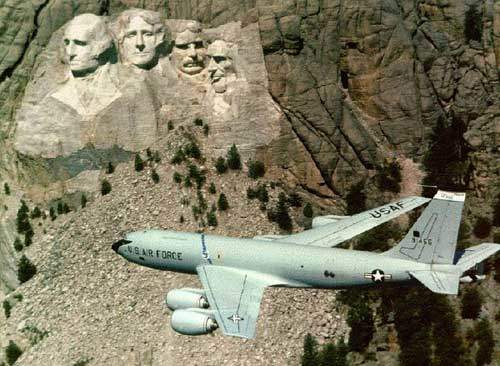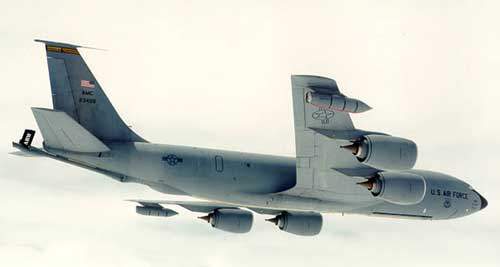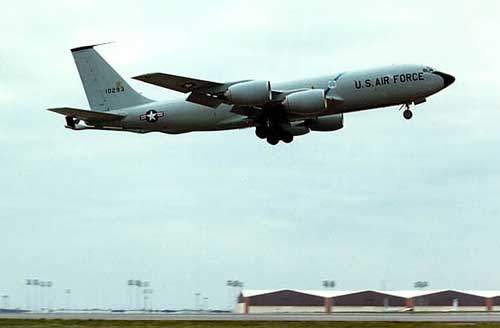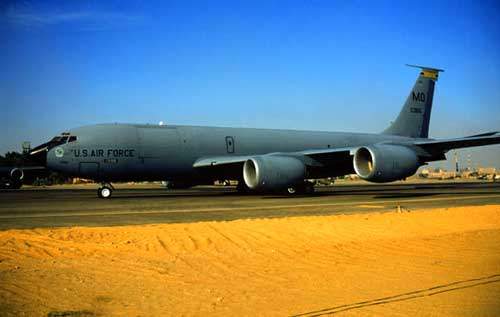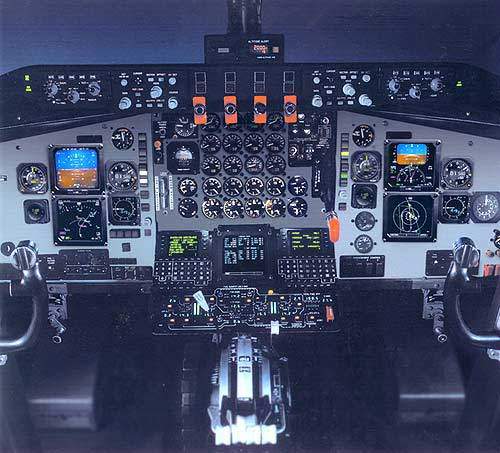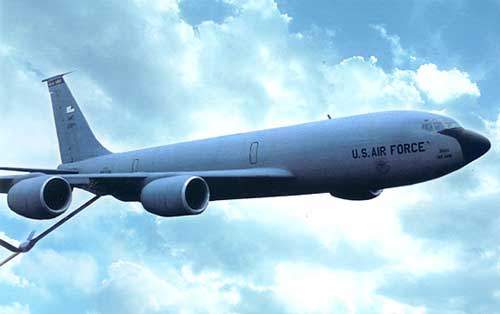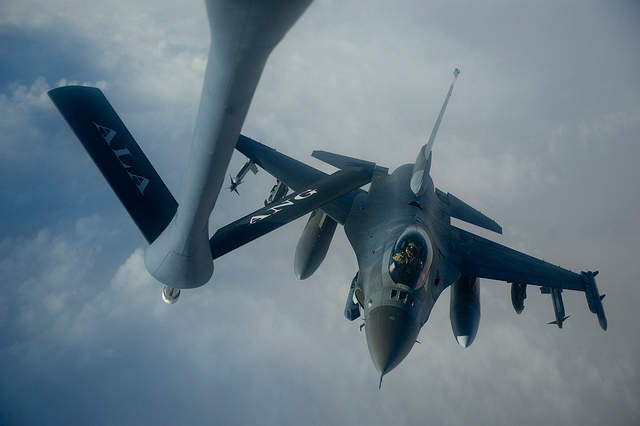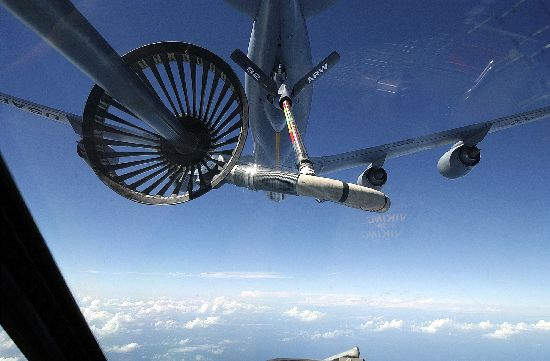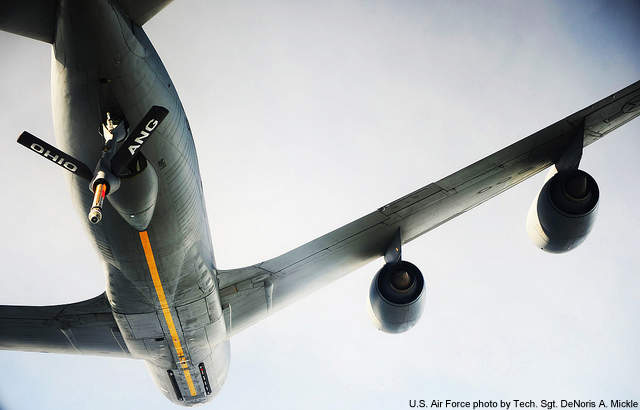Boeing built 732 KC-135 Stratotankers for the US Air Force between 1957 and 1965. The US Air Force still has about 550 KC-135 Stratotankers in service (active duty, 253; Air National Guard, 222; Air Force Reserve, 70) and has made substantial investment in a series of upgrade programs, including reskinning of the lower wing surfaces, the installation of new CFM56 engines and new avionics systems.
411 of the aircraft in service are the upgraded 135R models and 134 the older 135E. The KC-135 is also in service with the air forces of France (11 aircraft), Turkey (seven) and Singapore (four).
The US Air Force received testing equipment from Cubic Defence Systems as part of the contract signed in February 2010. The testing equipment, which includes small toolbox-sized test sets, will be used to examine and troubleshoot the auxillary power unit (APU) fitted in the tail section of KC-135 refuelling aircraft. The APU produces the electricity that fires up the KC-135’s engines.
KC-135 aerial refuelling method
The primary air fuel transfer method is through the tanker’s flying boom, controlled by an operator stationed at the rear of the fuselage. USAF aircraft have primarily used this boom and receptacle refuelling technique.
A shuttlecock drogue can be trailed behind the boom and used to refuel aircraft equipped with refuelling probes. Aircraft fitted with the boom drogue cannot refuel boom and receptacle aircraft.
Stratotanker hose and drogue air refuelling
About 45 US Air Force KC-135R Stratotankers are fitted with mk32B wingtip hose and drogue air refuelling pods, which are supplied by Flight Refuelling Ltd.
These are capable of refuelling Navy and Nato aircraft, which use a probe and drogue system instead of a boom and receptacle. The receiving aircraft approaches the tanker and its probe makes contact with a hose reeled out and trailing from the tanker.
The additional system allows the KC-135R to refuel both probe / drogue and boom / receptacle aircraft on a single mission and to refuel two probe / drogue aircraft simultaneously.
The installation of wingtip refuelling pods involves a major modification and refit to the entire aircraft, including modifications to the wing and fuselage fuel tanks, additional fuel control systems and the installation of indicators and circuit breakers on the flight deck.
Inside the refuelling pods, a collapsible funnel-shaped drogue is attached to a hose, which is reeled out to trail behind the wing of the aircraft. The hose is fitted with a constant tension spring to give stability to the hose while it is extended.
A joint semi annual aerial refuelling training exercise was performed by the US Air Force’s KC-135 Stratotanker in December 2009 with 30 Royal Danish Air Force’s F-16 fighting falcons to strengthen operational readiness and mutual trust between the Nato allies.
Cargo
Passengers and up to 37,650kg cargo can be carried on the cargo deck above the refuelling systems.
KC-135 Stratotanker modernisation programme
The USAF selected Rockwell Collins to carry out the modernisation of the avionics system under the KC-135 Pacer CRAG (compass, radar and global positioning system) programme.
The upgraded avionics include cockpit enhancements with the Collins FMS-800 integrated flight management system, Collins FDS-255 liquid crystal flat-panel multifunction flight display, and the Collins WXR-700X forward-looking predictive windshear weather radar.
The flight management system is integrated with a traffic alert and collision avoidance system (TCAS) and an enhanced ground proximity warning system (EGPWS).
Subsequent to the Pacer CRAG programme, the USAF selected Rockwell Collins to update the KC-135 flight deck in support of the global air traffic management (GATM) initiative. The GATM upgrade program will focus primarily on upgrading the aircraft’s communication and navigation systems to free operation in civil airspace. 50 of the 550 USAF aircraft received the upgrade under the Phase I low-rate initial production contract and the first production aircraft was delivered in August 2003.
The second LRIP contract, signed in July 2003, provided for a further 25 aircraft to be upgraded. The phase II full rate production contract for 30 more systems was signed in April 2004. As of March 2008, 229 upgraded aircraft had been delivered.
GATM additions to the communications system include an Aero-I SAT-2000 satellite communications system and two FANs (future air navigation) capable CMU-900 Communication Management Units for data link applications. Also, the addition of two Collins integrated processing centres provides an integrated, modularised platform for hosting several partitioned GATM-related software applications.
GATM additions to the navigation system include two Collins GNLU-955M multi-mode receivers, which contain individual modules for GPS, MLS and FM-Immune VOR/ILS (VHF omni-directional radio range steering guidance linked with an instrument landing system) capabilities. Additionally, one existing and one newly added embedded global positioning system / inertial navigation system (EGI) unit will possess 12-channel, all-in-view GPS receivers.
Rockwell Collins was chosen by the US Air Force to provide engineering, manufacturing and development (EMD) of the KC-135 as part of the block 45 cockpit upgrade programme.
The contract will overhaul the aircraft’s flight deck with advanced autopilot, flight director, radar altimeter and electronic engine instrument display to enhance navigtional capabilities. The unused equipment will be replaced with digital avionics to increase safety, reliability and efficiency.
Two prototype aircraft will be modified during the EMD phase which will establish the production baseline for 415 additional aircraft to receive the Block 45 upgrade.
Mission variants
Some KC-135 aircraft have been configured for other missions such as reconnaissance and as a flying command post.
The US Air Combat Command operates 17 RC-135V/W rivet joint reconnaissance aircraft and the OC-135B open skies observation aircraft and the US Strategic Command operates the EC-135 flying command post.
The US Strategic Command has one EC-135C on alert status at all times, ready to take command if ground control is compromised.
Engines
The KC-135R aircraft has been updated with more efficient CFM International CFM-56 engines, which burn up to 25% less fuel and provide greater thrust than previously fitted engines. The efficiency of the engines enable the aircraft to offload 50% more fuel on a medium-radius, 1,725-mile refuelling mission. 410 of the USAF fleet of 546 KC-135s have been re-engined. The remainder have Pratt & Whitney TF33-102 engines.
Performance
The KC-135 can climb at the rate of 1,490m a minute. The maximum and cruise speed of the aircraft are 933km/h and 852km/h respectively. The range is 2,419km. The ferry range and service ceiling of are 17,766km and 15,200m.
The aircraft weighs around 44,663kg and the maximum take-off weight is 146,300kg.

